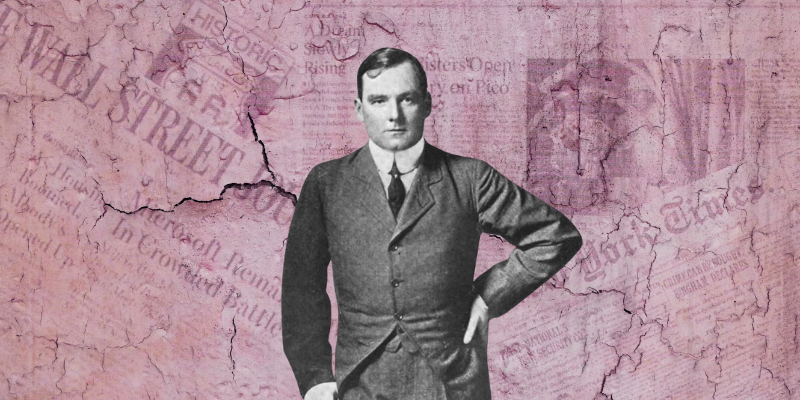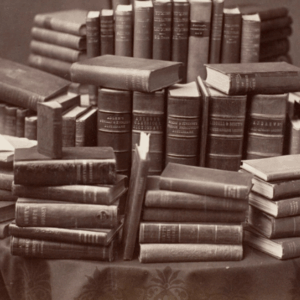
How America’s First Star War Reporter Set the Tone For a Century of Journalism
Peter Maass Unpacks the Sensationalist—and Occasionally Biased—Work of Richard Harding Davis
Richard Harding Davis is regarded by many as the first war correspondent of modern American journalism—not because he was the first to cover nineteenth-century warfare, but because he attracted a large audience with vivid dispatches that made readers feel as though they were at his side, witnessing atrocities and other outrages committed by Spanish troops in Cuba. His reports stirred public outrage in the 1890s and helped shape US policy; what subsequent generations of journalists wrote about World War I, World War II, Korea, Vietnam, Afghanistan, and Iraq can be considered the derivative progeny of Davis’s passionate work.
While the strengths of his articles and books are genre defining, so, too, are their flaws. These shortcomings make Davis more essential to read: You would not fully understand the quandaries of contemporary war journalism if you were not familiar with the lacunae in his work. Just as the story of Adam and Eve would be less universal (and less compelling) if it didn’t involve the all-too-human error of biting into a forbidden apple, we would have less reason to study Davis if his work hadn’t been instrumentalized as propaganda by his most famous boss, William Randolph Hearst, and his most famous subject, Teddy Roosevelt.
What’s embedded in Cuba in War Time are not only the triumphs and stumbles of a single journalist, but those of generations who followed. The march of time has done little to perfect war reporting: It remains prone to the biases of correspondents and their editors, and to the pressures and manipulations of politicians and generals. There is an abundance of subpar work that misleads the public. We should cherish Davis for his eternally relevant flaws as much as we might judge him for them.
The march of time has done little to perfect war reporting: It remains prone to the biases of correspondents and their editors, and to the pressures and manipulations of politicians and generals.
Born in 1864, Davis seemed destined to perform the work he pioneered. His mother was a prominent novelist, and his father was the editor of a Philadelphia newspaper. After attending Lehigh and Johns Hopkins University, he rose quickly in journalism and in 1896 was hired by Hearst to report from Cuba alongside the celebrated artist Frederic Remington.
If you thought the phenomenon of overhyped anchors on the front lines was an invention of television, just look at the front page of the New York Journal on January 17, 1897, which had the banner headline, “Richard Harding Davis and Frederic Remington in Cuba for the Journal,” with half the page devoted to their portraits. This was the golden age of yellow journalism, and Hearst was pushing for the US to intervene against the Spanish. As he apocryphally wired Remington, “You furnish the pictures, I’ll furnish the war.”
Hearst didn’t need to furnish anything—a brutal war was underway. Davis offered acute descriptions of what he saw, as well as startlingly clear-eyed analyses of the underlying forces at play. As you read the first pages of Cuba in War Time, you will be surprised at how crisply Davis describes wartime dynamics that so many people—including politicians who keep sending soldiers into unwinnable wars—mistakenly regard as novel to their times or completely unexpected. Almost anyone who covers a war believes, in a moment of hubris, that they are making an original point, but Davis’s work is a humbling reminder of how downstream most have been.
However unique our moment might feel, we are caught in patterns that long predate us.
Take the following passage, for instance, and substitute “fortified places” with the “green zones” that constituted US bases after the 2003 invasion of Iraq. “The island is divided into two great military camps, one situated within the forts, and the other scattered over the fields and mountains outside them,” Davis writes of Cuba. “The Spaniards have absolute control over everything within the fortified places…The insurgents are in possession of all the rest. They are not in fixed possession, but they have control much as a mad bull may be said to have control of a ten-acre lot when he goes on the rampage.” Swap “strategic hamlets” for “green zones” and you’re in Vietnam. Davis saw and described the illusion of territorial control in guerrilla war fare long before the rest of us.
More than seventy years before the Vietnam War gave us its infamous “body counts,” Davis also was documenting the fabrication of enemy casualties. The Spanish military inflated, or just created out of thin air, the numbers of Cuban rebels it supposedly killed. “I counted the cartridges my men had used,” a Spanish officer says in the pages of this book. “I found they had expended four hundred. By allowing ten bullets to each man killed, I was able to learn that we had killed forty men.” However unique our moment might feel, we are caught in patterns that long predate us.
Davis notes, for example, the financial incentives that make modern warfare a profitable enterprise for its combatants. It’s a phenomenon that Marine General Smedley Butler described in his 1935 book, War Is a Racket; that was fictionalized in Joseph Heller’s Catch-22; that was evoked in President Dwight Eisenhower’s warnings of the “military industrial complex”; and it can be seen today in the perennially flush balance sheets of military contractors that continue to service the American presence in Iraq and elsewhere.
“The Spanish officers, as well as the planters—the very men to whom Spain looks to end the rebellion—are chief among those who are keeping it alive,” Davis writes. “They receive double pay while they are on foreign service, whether they are fighting or not, promotion comes twice as quickly as in peace, and orders and crosses are distributed by the gross. They are also able to make small fortunes out of forced loans from planters and suspects, and they undoubtedly hold back for themselves a great part of the pay of the men.” Davis adds that while a Spanish officer might be willing to die for his country, “should he be permitted to live he will not hesitate to rob her.”
That cutting line is just one example of Davis’s superb skill as a writer. A chapter titled “The Death of Rodriguez,” which recounts the execution of a young Cuban insurgent captured in battle, sets the standard for war reporting in the century that followed. “I witnessed his execution, and what follows is an account of the way he went to death,” Davis begins. “Although Rodriguez could not know it, there was one person present when he died who felt keenly for him, and who was a sympathetic though unwilling spectator.”
Under a full moon visible through the pre-dawn mist, a formation of soldiers silently escorts the doomed rebel. Rodriquez is accompanied by two priests and kisses a cross one of them holds; the priests move to the side, one of them covering his face with his hands. The firing squad raises their weapons, pulls back their triggers, and, in a momentary reprieve that is a small torture, refrain from firing because an officer has noticed that their bullets could hit soldiers a distance away. Expecting a volley of death, Rodriguez instead feels a hand on his shoulder and hears a voice telling him to move a few paces.
The Hearst-like intervention in 2003 was not much more subtle than in the 1890s, as I discovered when I later worked on a lengthy investigation into the creation of this “mission accomplished” moment.
The reader knows how things will end, yet the drama of this century-and-a-quarter-old tale remains gripping—a forerunner of what the literary critic James Wood described as the “cunning control of suspense” in George Orwell’s 1931 account of a colonial hanging in Burma. The shots are fired once Rodriquez stands in the new position, and he slumps to the ground, gone from the world. The soldiers walk past the young man’s corpse as they return to their camp, and the sun rises on the town of Santa Clara. Davis looks at the body on the wet grass, “with his motionless arms still tightly bound behind him, with the scapula twisted awry across his face and the blood from his breast sinking into the soil he had tried to free.”
Emotionally forceful, this passage also exposes Davis’s limitations. He showed little interest in the dream for which Rodriquez gave his life. One common critique of Davis’s work is that he served as a propagandist for US intervention—not to liberate Cuba but to give it a different master. This is where a flaw in his work reveals an original—and continuing—sin of war reporting. The pleas we have heard for supposed humanitarian intervention in recent conflicts have rarely had a more concise expression than what Davis wrote about Cuba well more than a century ago. “Why should we not go a step farther and a step higher, and interfere in the name of humanity?” he argued. “Not because we are Americans, but because we are human beings, and because, within eighty miles of our coast, Spanish officials are killing men and women as wantonly as though they were field mice, not in battle, but in cold blood.”
The Spanish empire was declining when an uprising began in its Cuban colony in 1895. Proponents of American expansion realized the weakened Spanish could be defeated in Cuba, and that Spain’s colonies in Puerto Rico, Guam, and the Philippines could come under US control, too. That’s why Hearst and others were keen to send their reporters to Cuba, so that popular outrage could be stirred up against the brutal Spanish. Davis’s dispatches played their intended role, though the pivotal event was the mysterious 1898 sinking of the USS Maine in Havana harbor, which was blamed on Spain.
After the US imposed a blockade of Cuba, the Spanish-American War began. It lasted less than six months, ending with a resounding American victory. The enduring dilemma—then as now—is that the passions aroused over atrocities can be easily abused. When fact and ideology become entangled, truth is turned into propaganda. Sometimes the distortion is not the fault of the reporter but of their editors or proprietors—and here again, Cuba in War Time provides an excruciating example.
In one chapter, Davis describes Spanish forces boarding an American vessel in Havana’s harbor and searching several young Cuban women aboard it—an incident that occurred before the sinking of the Maine and the outbreak of Spanish-American hostilities. Davis writes in these pages that the searches were carried out by women. That’s what he also wrote in the article he submitted to Hearst’s New York Journal, except the Journal altered it to falsely state the search was conducted by men—a higher affront to American sensitivities that would be of greater use to Hearst’s pro-intervention agenda. Davis was outraged, and never worked for Hearst again. When his article was adapted into this book, Davis made a point of noting that his original dispatch, before adjustment by the Hearst paper, said women conducted the search.
Hearst’s editorial meddling was crude but not anomalous. What Davis saw and experienced in his life was the starting gun for almost every holy and profane act in war reporting since then. In 2003, I happened to be standing in Baghdad’s Firdos Square and watched US Marines topple a statue of Saddam Hussein—a colorful event that was broadcast live across the world and that most journalists on the ground realized had modest significance, as fighting raged in the rest of the city, looting was rampant, and, as many suspected, a civil war was on the horizon.
The Hearst-like intervention in 2003 was not much more subtle than in the 1890s, as I discovered when I later worked on a lengthy investigation into the creation of this “mission accomplished” moment. A veteran war photographer who was casually observing the toppling got an abrupt call on his satellite phone from an editor in New York who was watching on television and wanted to be sure his man in Baghdad was going to be sending pictures, because this was the top story, destined for the cover. A reporter for a newspaper on the West Coast filed a dispatch downplaying the toppling, but when he woke the next day his article had been rewritten by editors to describe a joyous scene of liberation.
The internal conflict between truth and propaganda is timeless.
It’s hard to resist the pull of mythmaking. Who didn’t want to believe it really was “mission accomplished” in Baghdad? How could all those generals and politicians be wrong?
There was a similar impulse in Cuba once American forces landed in 1898 and began fighting the Spanish. Davis was there, and his celebrated dispatch, “The Battle of San Juan Hill,” described a heroic charge. The initial portion of the battle involved incompetence by the commanding US general—Davis noted that “a series of military blunders had brought seven thousand American soldiers into a chute of death from which there was no escape except by taking the enemy who held it by the throat and driving him out and beating him down.” This was the moment when, Davis wrote, the Rough Riders, led by Teddy Roosevelt, came to the rescue: “Roosevelt, mounted high on horseback, and charging the rifle pits at a gallop and quite alone, made you feel that you would like to cheer.”
Davis’s lively dispatch turned Roosevelt into a national hero and set him on a path to become governor of New York and president of the United States. Yet here another flaw in Davis’s reporting comes into view: His account has been credibly challenged as exaggerated, if not outright invented. The hill in question was apparently not San Juan but an adjacent one called Kettle, and Roosevelt did not lead the charge in the way Davis described it. What Davis reported aligned too closely with what Roosevelt claimed had happened. This would not be the last time a reporter was insufficiently skeptical of the military’s official story.
War reporters are honored for their physical bravery and their traumatic devotion to bearing witness. The hardship they face occurs during the fact-collecting part of their job— dodging bullets, watching executions, cajoling generals, and negotiating with warlords.
Davis’s work reveals a quieter type of adversity. After the information is gathered, reporters must figure out what to do with the incendiary material in their possession, how to convey the complexities and truths and lies of what they have seen and been told. They must parry the pressures that come from editors, peers, politicians, and their own emotions and biases. Reading Cuba in War Time, we’re reminded that war reporting was never free of this struggle and vacillation. The internal conflict between truth and propaganda is timeless. The world of Richard Harding Davis is today’s world.
__________________________________

From Cuba in War Time. Used with the permission of the publisher, Columbia Global Reports. Copyright © 2025 by Peter Maass.
Peter Maass
Peter Maass is the author of the award-winning “Love Thy Neighbor: A Story of War,” about the conflict in Bosnia. He covered the wars in Afghanistan and Iraq for The New York Times Magazine. This article is the introduction to a new edition of Richard Harding Davis’s classic book, “Cuba in War Time,” published by Columbia Global Reports. Maass is currently a fellow at the Leon Levy Center for Biography, working on a book about Jacob Schiff and non-Zionism in America.












